Financial Statement Analysis and Ratio Interpretation of Two Companies
VerifiedAdded on 2020/12/10
|12
|4132
|476
Report
AI Summary
This report provides a detailed financial statement analysis of Hilton Foods and Tate & Lyle PLC, covering ratio analysis and interpretation for the years 2015, 2016, and 2017. The analysis includes current ratio, cash flow ratio, gearing ratio, payable days, gross profit margin, inventory turnover, net profit margin, interest coverage, and quick ratio. The report interprets each ratio, comparing the performance of both companies and highlighting their financial strengths and weaknesses. Furthermore, the report assesses the influence of internal and external factors on the future prospects of both companies, providing insights into their financial health and potential for growth. The report concludes with an overall evaluation of the companies' financial positions based on the performed analysis.
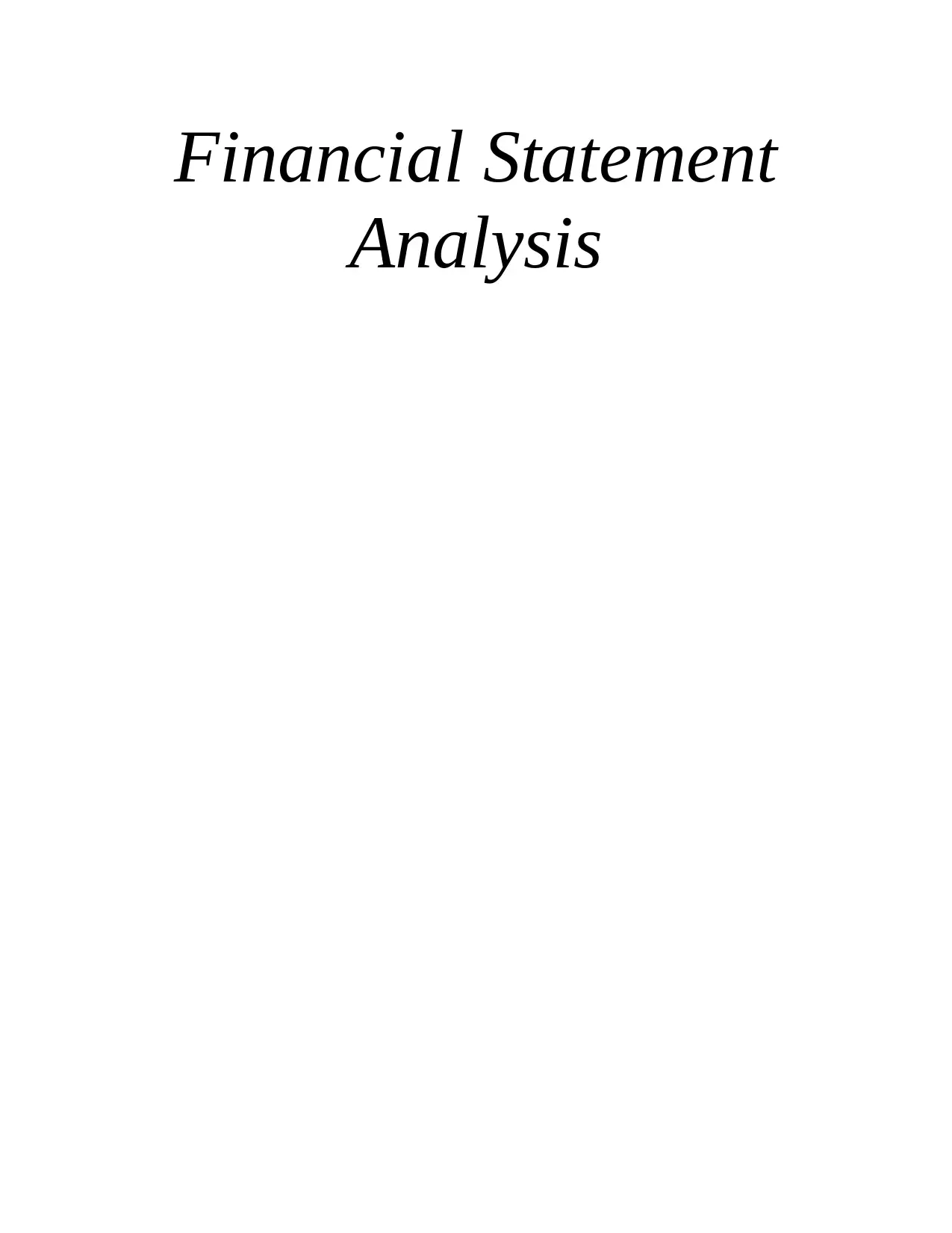
Financial Statement
Analysis
Analysis
Paraphrase This Document
Need a fresh take? Get an instant paraphrase of this document with our AI Paraphraser
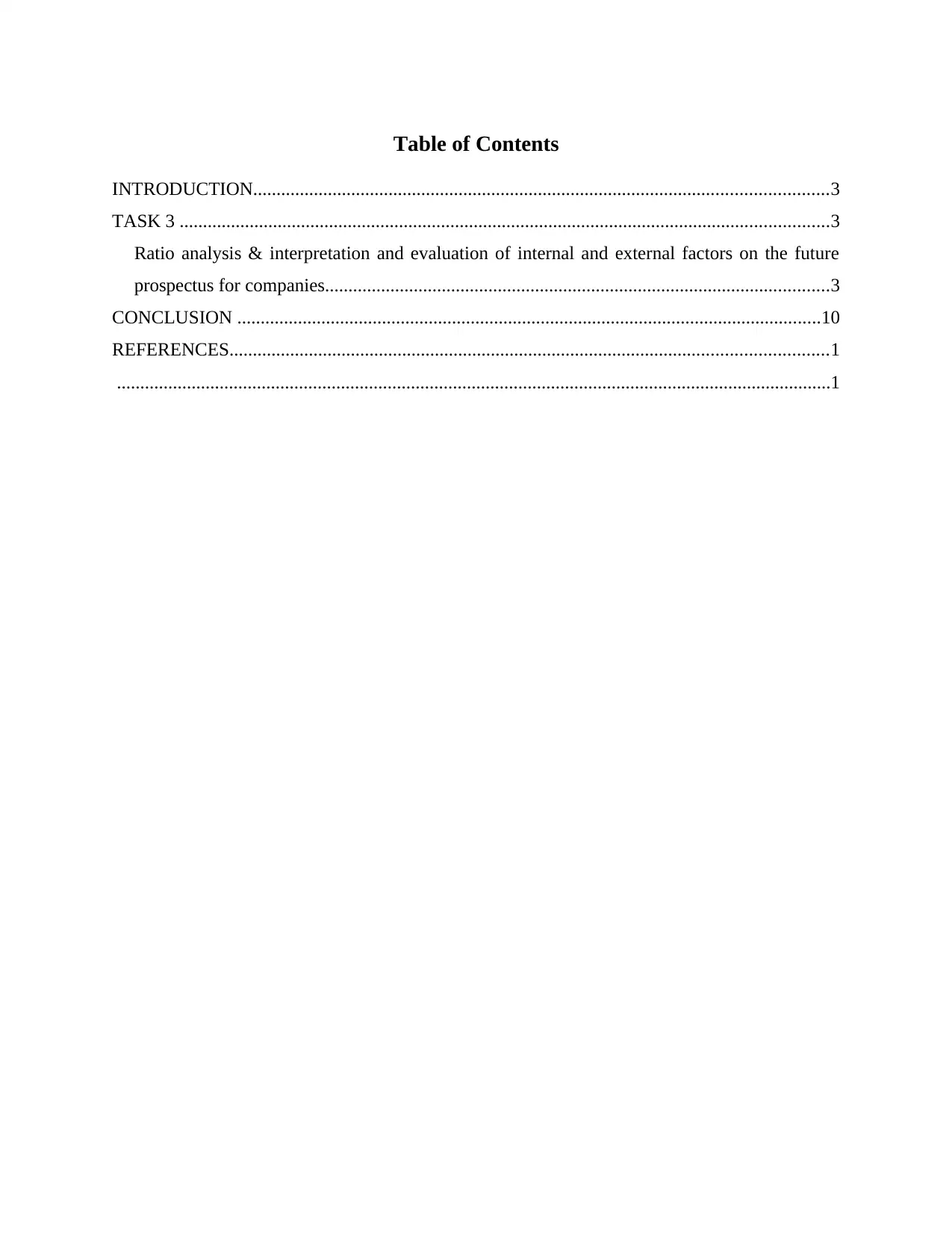
Table of Contents
INTRODUCTION...........................................................................................................................3
TASK 3 ...........................................................................................................................................3
Ratio analysis & interpretation and evaluation of internal and external factors on the future
prospectus for companies............................................................................................................3
CONCLUSION .............................................................................................................................10
REFERENCES................................................................................................................................1
.........................................................................................................................................................1
INTRODUCTION...........................................................................................................................3
TASK 3 ...........................................................................................................................................3
Ratio analysis & interpretation and evaluation of internal and external factors on the future
prospectus for companies............................................................................................................3
CONCLUSION .............................................................................................................................10
REFERENCES................................................................................................................................1
.........................................................................................................................................................1
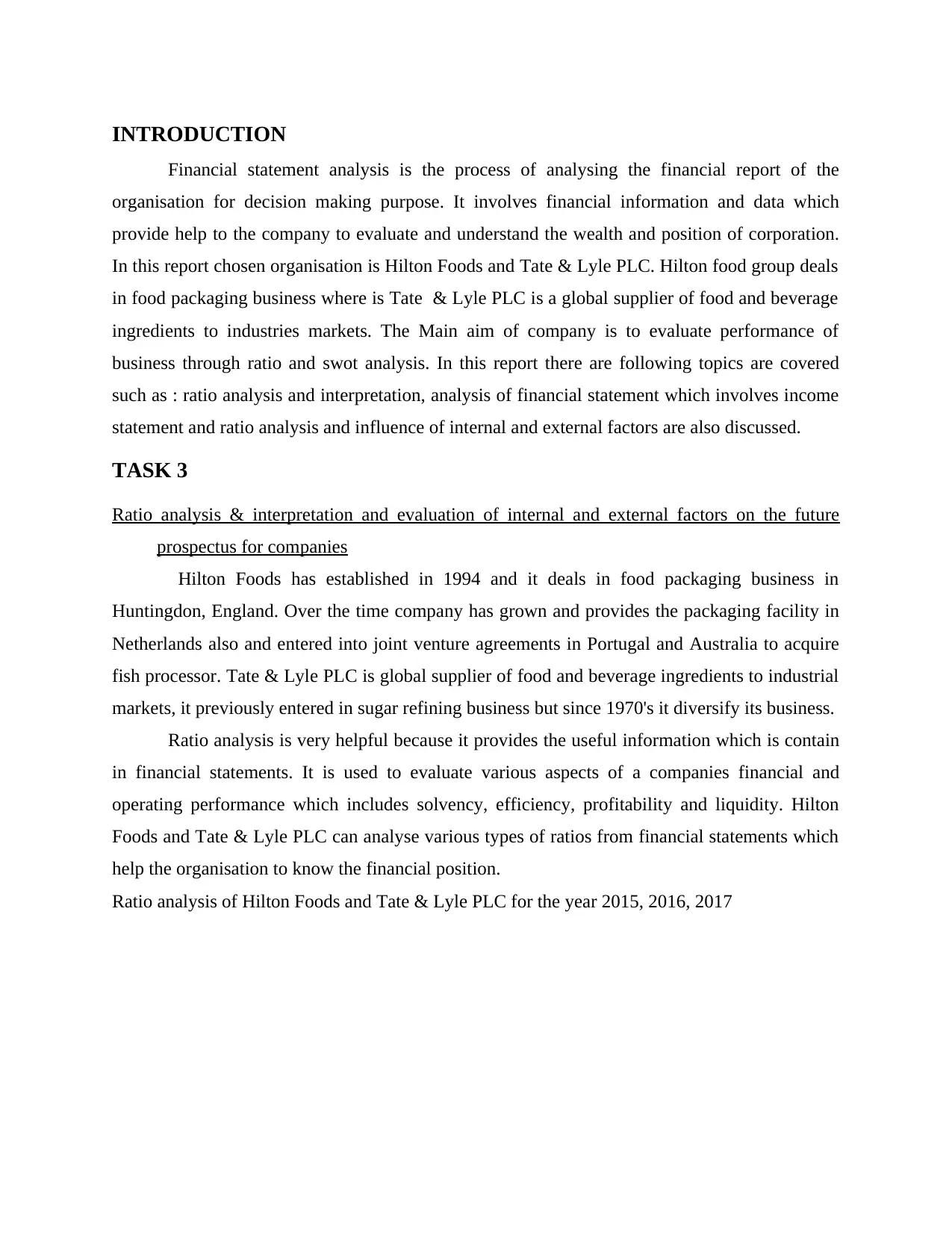
INTRODUCTION
Financial statement analysis is the process of analysing the financial report of the
organisation for decision making purpose. It involves financial information and data which
provide help to the company to evaluate and understand the wealth and position of corporation.
In this report chosen organisation is Hilton Foods and Tate & Lyle PLC. Hilton food group deals
in food packaging business where is Tate & Lyle PLC is a global supplier of food and beverage
ingredients to industries markets. The Main aim of company is to evaluate performance of
business through ratio and swot analysis. In this report there are following topics are covered
such as : ratio analysis and interpretation, analysis of financial statement which involves income
statement and ratio analysis and influence of internal and external factors are also discussed.
TASK 3
Ratio analysis & interpretation and evaluation of internal and external factors on the future
prospectus for companies
Hilton Foods has established in 1994 and it deals in food packaging business in
Huntingdon, England. Over the time company has grown and provides the packaging facility in
Netherlands also and entered into joint venture agreements in Portugal and Australia to acquire
fish processor. Tate & Lyle PLC is global supplier of food and beverage ingredients to industrial
markets, it previously entered in sugar refining business but since 1970's it diversify its business.
Ratio analysis is very helpful because it provides the useful information which is contain
in financial statements. It is used to evaluate various aspects of a companies financial and
operating performance which includes solvency, efficiency, profitability and liquidity. Hilton
Foods and Tate & Lyle PLC can analyse various types of ratios from financial statements which
help the organisation to know the financial position.
Ratio analysis of Hilton Foods and Tate & Lyle PLC for the year 2015, 2016, 2017
Financial statement analysis is the process of analysing the financial report of the
organisation for decision making purpose. It involves financial information and data which
provide help to the company to evaluate and understand the wealth and position of corporation.
In this report chosen organisation is Hilton Foods and Tate & Lyle PLC. Hilton food group deals
in food packaging business where is Tate & Lyle PLC is a global supplier of food and beverage
ingredients to industries markets. The Main aim of company is to evaluate performance of
business through ratio and swot analysis. In this report there are following topics are covered
such as : ratio analysis and interpretation, analysis of financial statement which involves income
statement and ratio analysis and influence of internal and external factors are also discussed.
TASK 3
Ratio analysis & interpretation and evaluation of internal and external factors on the future
prospectus for companies
Hilton Foods has established in 1994 and it deals in food packaging business in
Huntingdon, England. Over the time company has grown and provides the packaging facility in
Netherlands also and entered into joint venture agreements in Portugal and Australia to acquire
fish processor. Tate & Lyle PLC is global supplier of food and beverage ingredients to industrial
markets, it previously entered in sugar refining business but since 1970's it diversify its business.
Ratio analysis is very helpful because it provides the useful information which is contain
in financial statements. It is used to evaluate various aspects of a companies financial and
operating performance which includes solvency, efficiency, profitability and liquidity. Hilton
Foods and Tate & Lyle PLC can analyse various types of ratios from financial statements which
help the organisation to know the financial position.
Ratio analysis of Hilton Foods and Tate & Lyle PLC for the year 2015, 2016, 2017
⊘ This is a preview!⊘
Do you want full access?
Subscribe today to unlock all pages.

Trusted by 1+ million students worldwide
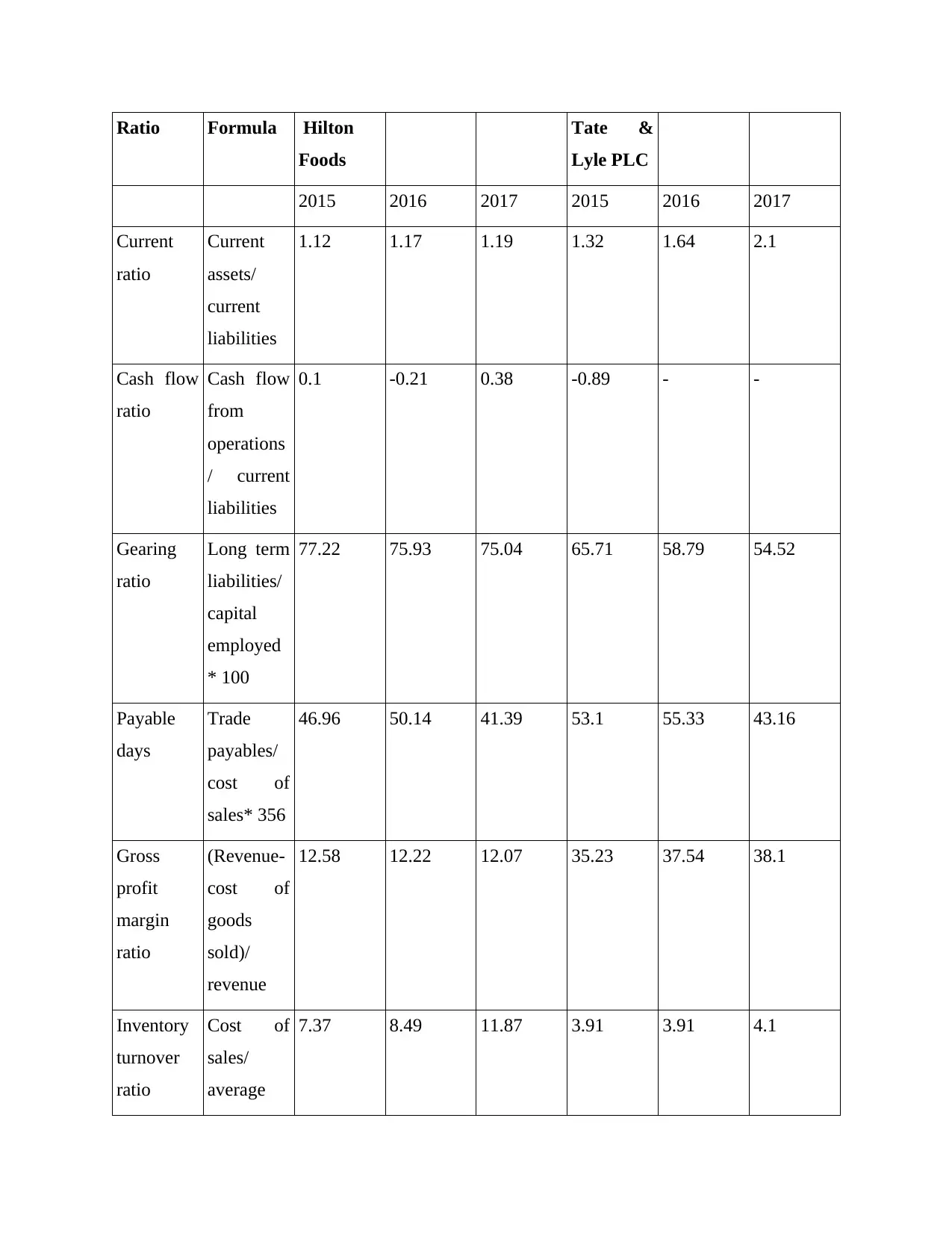
Ratio Formula Hilton
Foods
Tate &
Lyle PLC
2015 2016 2017 2015 2016 2017
Current
ratio
Current
assets/
current
liabilities
1.12 1.17 1.19 1.32 1.64 2.1
Cash flow
ratio
Cash flow
from
operations
/ current
liabilities
0.1 -0.21 0.38 -0.89 - -
Gearing
ratio
Long term
liabilities/
capital
employed
* 100
77.22 75.93 75.04 65.71 58.79 54.52
Payable
days
Trade
payables/
cost of
sales* 356
46.96 50.14 41.39 53.1 55.33 43.16
Gross
profit
margin
ratio
(Revenue-
cost of
goods
sold)/
revenue
12.58 12.22 12.07 35.23 37.54 38.1
Inventory
turnover
ratio
Cost of
sales/
average
7.37 8.49 11.87 3.91 3.91 4.1
Foods
Tate &
Lyle PLC
2015 2016 2017 2015 2016 2017
Current
ratio
Current
assets/
current
liabilities
1.12 1.17 1.19 1.32 1.64 2.1
Cash flow
ratio
Cash flow
from
operations
/ current
liabilities
0.1 -0.21 0.38 -0.89 - -
Gearing
ratio
Long term
liabilities/
capital
employed
* 100
77.22 75.93 75.04 65.71 58.79 54.52
Payable
days
Trade
payables/
cost of
sales* 356
46.96 50.14 41.39 53.1 55.33 43.16
Gross
profit
margin
ratio
(Revenue-
cost of
goods
sold)/
revenue
12.58 12.22 12.07 35.23 37.54 38.1
Inventory
turnover
ratio
Cost of
sales/
average
7.37 8.49 11.87 3.91 3.91 4.1
Paraphrase This Document
Need a fresh take? Get an instant paraphrase of this document with our AI Paraphraser
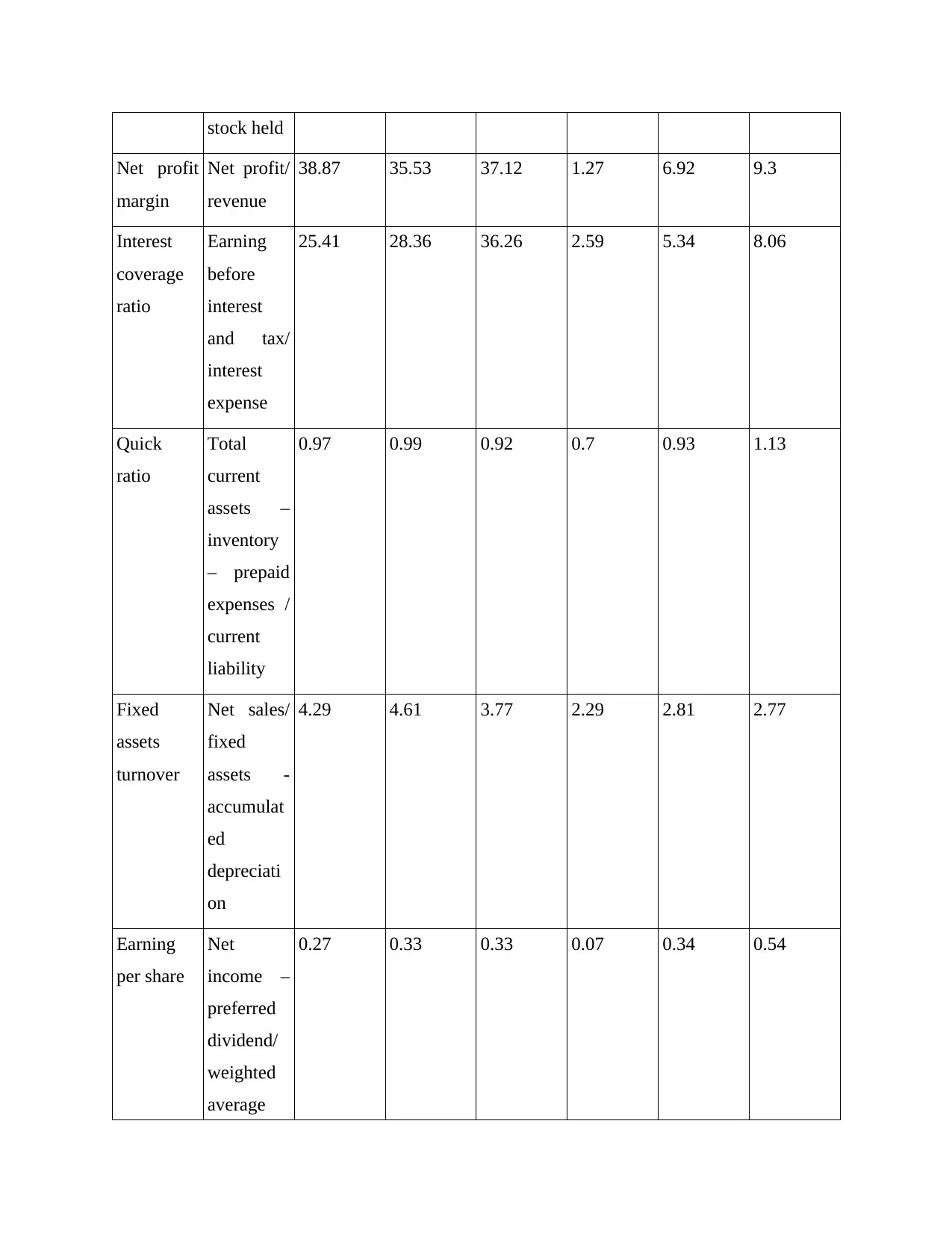
stock held
Net profit
margin
Net profit/
revenue
38.87 35.53 37.12 1.27 6.92 9.3
Interest
coverage
ratio
Earning
before
interest
and tax/
interest
expense
25.41 28.36 36.26 2.59 5.34 8.06
Quick
ratio
Total
current
assets –
inventory
– prepaid
expenses /
current
liability
0.97 0.99 0.92 0.7 0.93 1.13
Fixed
assets
turnover
Net sales/
fixed
assets -
accumulat
ed
depreciati
on
4.29 4.61 3.77 2.29 2.81 2.77
Earning
per share
Net
income –
preferred
dividend/
weighted
average
0.27 0.33 0.33 0.07 0.34 0.54
Net profit
margin
Net profit/
revenue
38.87 35.53 37.12 1.27 6.92 9.3
Interest
coverage
ratio
Earning
before
interest
and tax/
interest
expense
25.41 28.36 36.26 2.59 5.34 8.06
Quick
ratio
Total
current
assets –
inventory
– prepaid
expenses /
current
liability
0.97 0.99 0.92 0.7 0.93 1.13
Fixed
assets
turnover
Net sales/
fixed
assets -
accumulat
ed
depreciati
on
4.29 4.61 3.77 2.29 2.81 2.77
Earning
per share
Net
income –
preferred
dividend/
weighted
average
0.27 0.33 0.33 0.07 0.34 0.54
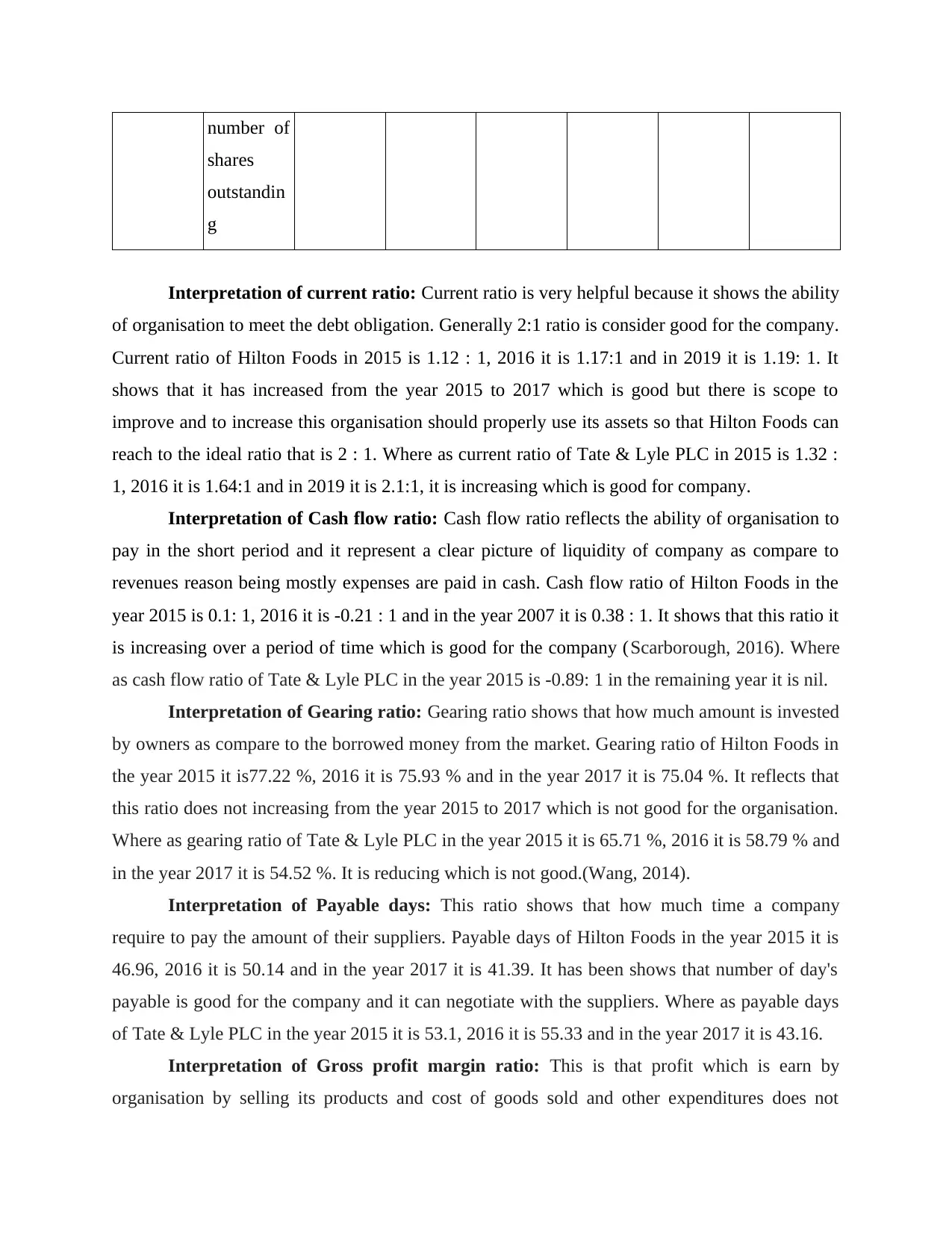
number of
shares
outstandin
g
Interpretation of current ratio: Current ratio is very helpful because it shows the ability
of organisation to meet the debt obligation. Generally 2:1 ratio is consider good for the company.
Current ratio of Hilton Foods in 2015 is 1.12 : 1, 2016 it is 1.17:1 and in 2019 it is 1.19: 1. It
shows that it has increased from the year 2015 to 2017 which is good but there is scope to
improve and to increase this organisation should properly use its assets so that Hilton Foods can
reach to the ideal ratio that is 2 : 1. Where as current ratio of Tate & Lyle PLC in 2015 is 1.32 :
1, 2016 it is 1.64:1 and in 2019 it is 2.1:1, it is increasing which is good for company.
Interpretation of Cash flow ratio: Cash flow ratio reflects the ability of organisation to
pay in the short period and it represent a clear picture of liquidity of company as compare to
revenues reason being mostly expenses are paid in cash. Cash flow ratio of Hilton Foods in the
year 2015 is 0.1: 1, 2016 it is -0.21 : 1 and in the year 2007 it is 0.38 : 1. It shows that this ratio it
is increasing over a period of time which is good for the company (Scarborough, 2016). Where
as cash flow ratio of Tate & Lyle PLC in the year 2015 is -0.89: 1 in the remaining year it is nil.
Interpretation of Gearing ratio: Gearing ratio shows that how much amount is invested
by owners as compare to the borrowed money from the market. Gearing ratio of Hilton Foods in
the year 2015 it is77.22 %, 2016 it is 75.93 % and in the year 2017 it is 75.04 %. It reflects that
this ratio does not increasing from the year 2015 to 2017 which is not good for the organisation.
Where as gearing ratio of Tate & Lyle PLC in the year 2015 it is 65.71 %, 2016 it is 58.79 % and
in the year 2017 it is 54.52 %. It is reducing which is not good.(Wang, 2014).
Interpretation of Payable days: This ratio shows that how much time a company
require to pay the amount of their suppliers. Payable days of Hilton Foods in the year 2015 it is
46.96, 2016 it is 50.14 and in the year 2017 it is 41.39. It has been shows that number of day's
payable is good for the company and it can negotiate with the suppliers. Where as payable days
of Tate & Lyle PLC in the year 2015 it is 53.1, 2016 it is 55.33 and in the year 2017 it is 43.16.
Interpretation of Gross profit margin ratio: This is that profit which is earn by
organisation by selling its products and cost of goods sold and other expenditures does not
shares
outstandin
g
Interpretation of current ratio: Current ratio is very helpful because it shows the ability
of organisation to meet the debt obligation. Generally 2:1 ratio is consider good for the company.
Current ratio of Hilton Foods in 2015 is 1.12 : 1, 2016 it is 1.17:1 and in 2019 it is 1.19: 1. It
shows that it has increased from the year 2015 to 2017 which is good but there is scope to
improve and to increase this organisation should properly use its assets so that Hilton Foods can
reach to the ideal ratio that is 2 : 1. Where as current ratio of Tate & Lyle PLC in 2015 is 1.32 :
1, 2016 it is 1.64:1 and in 2019 it is 2.1:1, it is increasing which is good for company.
Interpretation of Cash flow ratio: Cash flow ratio reflects the ability of organisation to
pay in the short period and it represent a clear picture of liquidity of company as compare to
revenues reason being mostly expenses are paid in cash. Cash flow ratio of Hilton Foods in the
year 2015 is 0.1: 1, 2016 it is -0.21 : 1 and in the year 2007 it is 0.38 : 1. It shows that this ratio it
is increasing over a period of time which is good for the company (Scarborough, 2016). Where
as cash flow ratio of Tate & Lyle PLC in the year 2015 is -0.89: 1 in the remaining year it is nil.
Interpretation of Gearing ratio: Gearing ratio shows that how much amount is invested
by owners as compare to the borrowed money from the market. Gearing ratio of Hilton Foods in
the year 2015 it is77.22 %, 2016 it is 75.93 % and in the year 2017 it is 75.04 %. It reflects that
this ratio does not increasing from the year 2015 to 2017 which is not good for the organisation.
Where as gearing ratio of Tate & Lyle PLC in the year 2015 it is 65.71 %, 2016 it is 58.79 % and
in the year 2017 it is 54.52 %. It is reducing which is not good.(Wang, 2014).
Interpretation of Payable days: This ratio shows that how much time a company
require to pay the amount of their suppliers. Payable days of Hilton Foods in the year 2015 it is
46.96, 2016 it is 50.14 and in the year 2017 it is 41.39. It has been shows that number of day's
payable is good for the company and it can negotiate with the suppliers. Where as payable days
of Tate & Lyle PLC in the year 2015 it is 53.1, 2016 it is 55.33 and in the year 2017 it is 43.16.
Interpretation of Gross profit margin ratio: This is that profit which is earn by
organisation by selling its products and cost of goods sold and other expenditures does not
⊘ This is a preview!⊘
Do you want full access?
Subscribe today to unlock all pages.

Trusted by 1+ million students worldwide
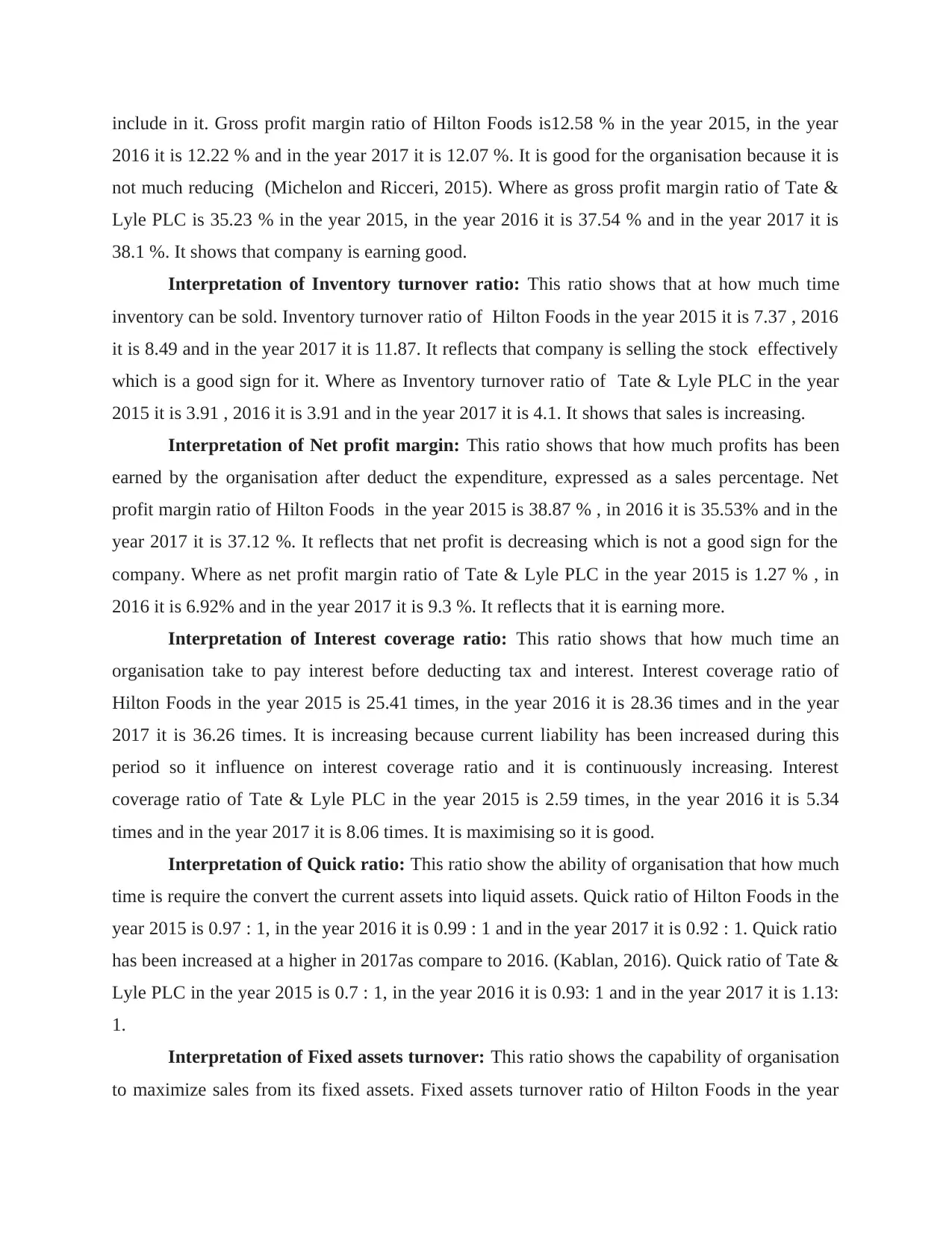
include in it. Gross profit margin ratio of Hilton Foods is12.58 % in the year 2015, in the year
2016 it is 12.22 % and in the year 2017 it is 12.07 %. It is good for the organisation because it is
not much reducing (Michelon and Ricceri, 2015). Where as gross profit margin ratio of Tate &
Lyle PLC is 35.23 % in the year 2015, in the year 2016 it is 37.54 % and in the year 2017 it is
38.1 %. It shows that company is earning good.
Interpretation of Inventory turnover ratio: This ratio shows that at how much time
inventory can be sold. Inventory turnover ratio of Hilton Foods in the year 2015 it is 7.37 , 2016
it is 8.49 and in the year 2017 it is 11.87. It reflects that company is selling the stock effectively
which is a good sign for it. Where as Inventory turnover ratio of Tate & Lyle PLC in the year
2015 it is 3.91 , 2016 it is 3.91 and in the year 2017 it is 4.1. It shows that sales is increasing.
Interpretation of Net profit margin: This ratio shows that how much profits has been
earned by the organisation after deduct the expenditure, expressed as a sales percentage. Net
profit margin ratio of Hilton Foods in the year 2015 is 38.87 % , in 2016 it is 35.53% and in the
year 2017 it is 37.12 %. It reflects that net profit is decreasing which is not a good sign for the
company. Where as net profit margin ratio of Tate & Lyle PLC in the year 2015 is 1.27 % , in
2016 it is 6.92% and in the year 2017 it is 9.3 %. It reflects that it is earning more.
Interpretation of Interest coverage ratio: This ratio shows that how much time an
organisation take to pay interest before deducting tax and interest. Interest coverage ratio of
Hilton Foods in the year 2015 is 25.41 times, in the year 2016 it is 28.36 times and in the year
2017 it is 36.26 times. It is increasing because current liability has been increased during this
period so it influence on interest coverage ratio and it is continuously increasing. Interest
coverage ratio of Tate & Lyle PLC in the year 2015 is 2.59 times, in the year 2016 it is 5.34
times and in the year 2017 it is 8.06 times. It is maximising so it is good.
Interpretation of Quick ratio: This ratio show the ability of organisation that how much
time is require the convert the current assets into liquid assets. Quick ratio of Hilton Foods in the
year 2015 is 0.97 : 1, in the year 2016 it is 0.99 : 1 and in the year 2017 it is 0.92 : 1. Quick ratio
has been increased at a higher in 2017as compare to 2016. (Kablan, 2016). Quick ratio of Tate &
Lyle PLC in the year 2015 is 0.7 : 1, in the year 2016 it is 0.93: 1 and in the year 2017 it is 1.13:
1.
Interpretation of Fixed assets turnover: This ratio shows the capability of organisation
to maximize sales from its fixed assets. Fixed assets turnover ratio of Hilton Foods in the year
2016 it is 12.22 % and in the year 2017 it is 12.07 %. It is good for the organisation because it is
not much reducing (Michelon and Ricceri, 2015). Where as gross profit margin ratio of Tate &
Lyle PLC is 35.23 % in the year 2015, in the year 2016 it is 37.54 % and in the year 2017 it is
38.1 %. It shows that company is earning good.
Interpretation of Inventory turnover ratio: This ratio shows that at how much time
inventory can be sold. Inventory turnover ratio of Hilton Foods in the year 2015 it is 7.37 , 2016
it is 8.49 and in the year 2017 it is 11.87. It reflects that company is selling the stock effectively
which is a good sign for it. Where as Inventory turnover ratio of Tate & Lyle PLC in the year
2015 it is 3.91 , 2016 it is 3.91 and in the year 2017 it is 4.1. It shows that sales is increasing.
Interpretation of Net profit margin: This ratio shows that how much profits has been
earned by the organisation after deduct the expenditure, expressed as a sales percentage. Net
profit margin ratio of Hilton Foods in the year 2015 is 38.87 % , in 2016 it is 35.53% and in the
year 2017 it is 37.12 %. It reflects that net profit is decreasing which is not a good sign for the
company. Where as net profit margin ratio of Tate & Lyle PLC in the year 2015 is 1.27 % , in
2016 it is 6.92% and in the year 2017 it is 9.3 %. It reflects that it is earning more.
Interpretation of Interest coverage ratio: This ratio shows that how much time an
organisation take to pay interest before deducting tax and interest. Interest coverage ratio of
Hilton Foods in the year 2015 is 25.41 times, in the year 2016 it is 28.36 times and in the year
2017 it is 36.26 times. It is increasing because current liability has been increased during this
period so it influence on interest coverage ratio and it is continuously increasing. Interest
coverage ratio of Tate & Lyle PLC in the year 2015 is 2.59 times, in the year 2016 it is 5.34
times and in the year 2017 it is 8.06 times. It is maximising so it is good.
Interpretation of Quick ratio: This ratio show the ability of organisation that how much
time is require the convert the current assets into liquid assets. Quick ratio of Hilton Foods in the
year 2015 is 0.97 : 1, in the year 2016 it is 0.99 : 1 and in the year 2017 it is 0.92 : 1. Quick ratio
has been increased at a higher in 2017as compare to 2016. (Kablan, 2016). Quick ratio of Tate &
Lyle PLC in the year 2015 is 0.7 : 1, in the year 2016 it is 0.93: 1 and in the year 2017 it is 1.13:
1.
Interpretation of Fixed assets turnover: This ratio shows the capability of organisation
to maximize sales from its fixed assets. Fixed assets turnover ratio of Hilton Foods in the year
Paraphrase This Document
Need a fresh take? Get an instant paraphrase of this document with our AI Paraphraser
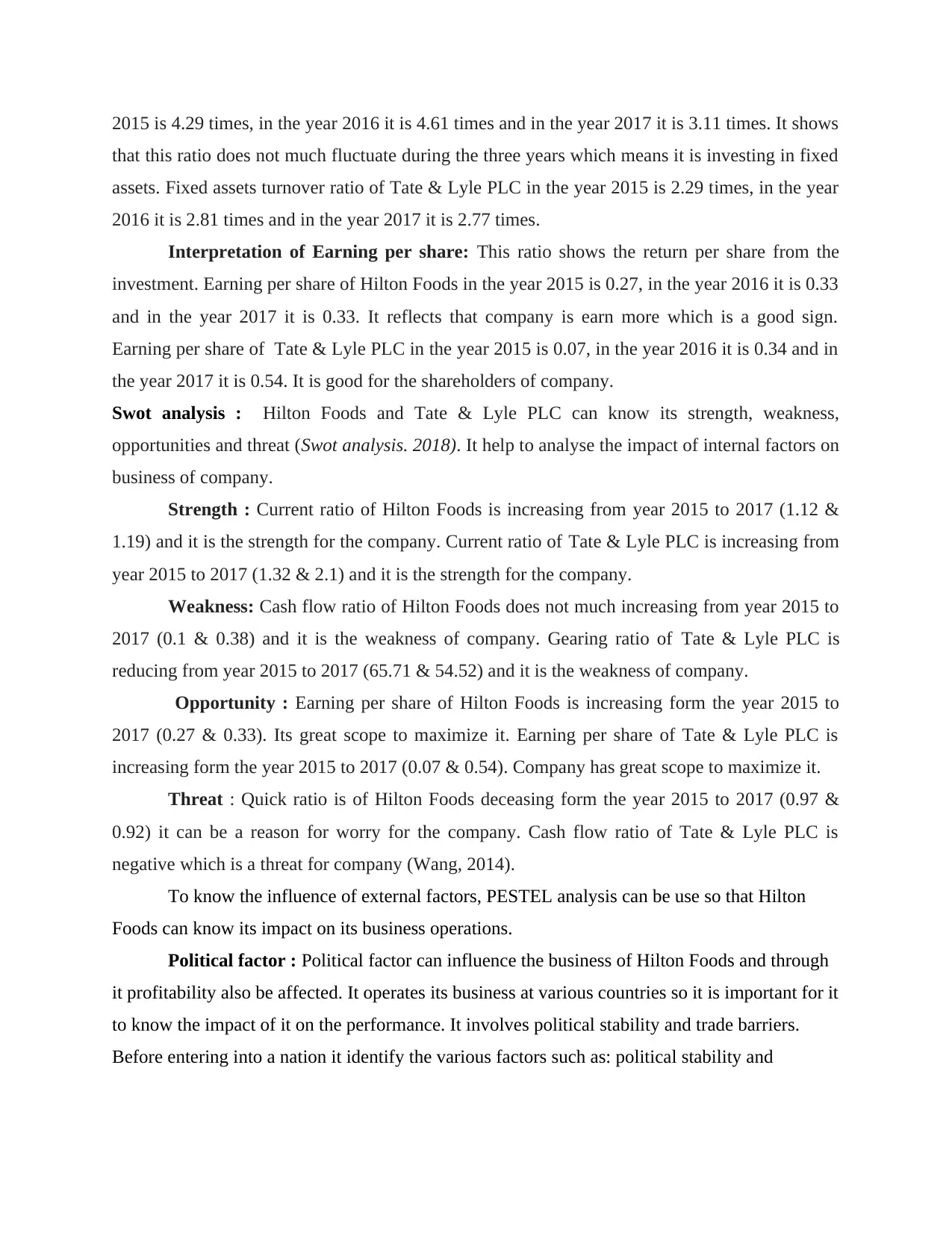
2015 is 4.29 times, in the year 2016 it is 4.61 times and in the year 2017 it is 3.11 times. It shows
that this ratio does not much fluctuate during the three years which means it is investing in fixed
assets. Fixed assets turnover ratio of Tate & Lyle PLC in the year 2015 is 2.29 times, in the year
2016 it is 2.81 times and in the year 2017 it is 2.77 times.
Interpretation of Earning per share: This ratio shows the return per share from the
investment. Earning per share of Hilton Foods in the year 2015 is 0.27, in the year 2016 it is 0.33
and in the year 2017 it is 0.33. It reflects that company is earn more which is a good sign.
Earning per share of Tate & Lyle PLC in the year 2015 is 0.07, in the year 2016 it is 0.34 and in
the year 2017 it is 0.54. It is good for the shareholders of company.
Swot analysis : Hilton Foods and Tate & Lyle PLC can know its strength, weakness,
opportunities and threat (Swot analysis. 2018). It help to analyse the impact of internal factors on
business of company.
Strength : Current ratio of Hilton Foods is increasing from year 2015 to 2017 (1.12 &
1.19) and it is the strength for the company. Current ratio of Tate & Lyle PLC is increasing from
year 2015 to 2017 (1.32 & 2.1) and it is the strength for the company.
Weakness: Cash flow ratio of Hilton Foods does not much increasing from year 2015 to
2017 (0.1 & 0.38) and it is the weakness of company. Gearing ratio of Tate & Lyle PLC is
reducing from year 2015 to 2017 (65.71 & 54.52) and it is the weakness of company.
Opportunity : Earning per share of Hilton Foods is increasing form the year 2015 to
2017 (0.27 & 0.33). Its great scope to maximize it. Earning per share of Tate & Lyle PLC is
increasing form the year 2015 to 2017 (0.07 & 0.54). Company has great scope to maximize it.
Threat : Quick ratio is of Hilton Foods deceasing form the year 2015 to 2017 (0.97 &
0.92) it can be a reason for worry for the company. Cash flow ratio of Tate & Lyle PLC is
negative which is a threat for company (Wang, 2014).
To know the influence of external factors, PESTEL analysis can be use so that Hilton
Foods can know its impact on its business operations.
Political factor : Political factor can influence the business of Hilton Foods and through
it profitability also be affected. It operates its business at various countries so it is important for it
to know the impact of it on the performance. It involves political stability and trade barriers.
Before entering into a nation it identify the various factors such as: political stability and
that this ratio does not much fluctuate during the three years which means it is investing in fixed
assets. Fixed assets turnover ratio of Tate & Lyle PLC in the year 2015 is 2.29 times, in the year
2016 it is 2.81 times and in the year 2017 it is 2.77 times.
Interpretation of Earning per share: This ratio shows the return per share from the
investment. Earning per share of Hilton Foods in the year 2015 is 0.27, in the year 2016 it is 0.33
and in the year 2017 it is 0.33. It reflects that company is earn more which is a good sign.
Earning per share of Tate & Lyle PLC in the year 2015 is 0.07, in the year 2016 it is 0.34 and in
the year 2017 it is 0.54. It is good for the shareholders of company.
Swot analysis : Hilton Foods and Tate & Lyle PLC can know its strength, weakness,
opportunities and threat (Swot analysis. 2018). It help to analyse the impact of internal factors on
business of company.
Strength : Current ratio of Hilton Foods is increasing from year 2015 to 2017 (1.12 &
1.19) and it is the strength for the company. Current ratio of Tate & Lyle PLC is increasing from
year 2015 to 2017 (1.32 & 2.1) and it is the strength for the company.
Weakness: Cash flow ratio of Hilton Foods does not much increasing from year 2015 to
2017 (0.1 & 0.38) and it is the weakness of company. Gearing ratio of Tate & Lyle PLC is
reducing from year 2015 to 2017 (65.71 & 54.52) and it is the weakness of company.
Opportunity : Earning per share of Hilton Foods is increasing form the year 2015 to
2017 (0.27 & 0.33). Its great scope to maximize it. Earning per share of Tate & Lyle PLC is
increasing form the year 2015 to 2017 (0.07 & 0.54). Company has great scope to maximize it.
Threat : Quick ratio is of Hilton Foods deceasing form the year 2015 to 2017 (0.97 &
0.92) it can be a reason for worry for the company. Cash flow ratio of Tate & Lyle PLC is
negative which is a threat for company (Wang, 2014).
To know the influence of external factors, PESTEL analysis can be use so that Hilton
Foods can know its impact on its business operations.
Political factor : Political factor can influence the business of Hilton Foods and through
it profitability also be affected. It operates its business at various countries so it is important for it
to know the impact of it on the performance. It involves political stability and trade barriers.
Before entering into a nation it identify the various factors such as: political stability and
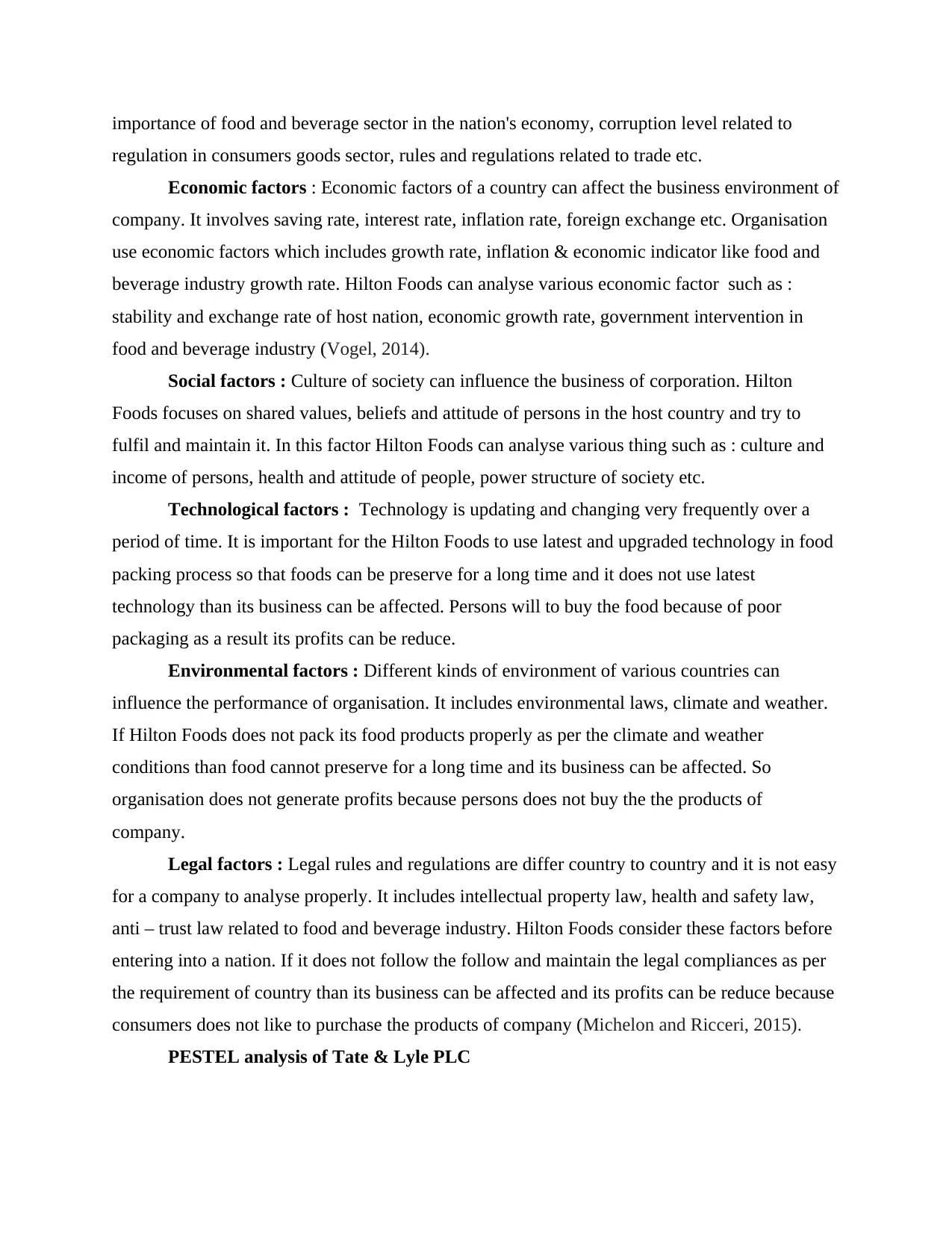
importance of food and beverage sector in the nation's economy, corruption level related to
regulation in consumers goods sector, rules and regulations related to trade etc.
Economic factors : Economic factors of a country can affect the business environment of
company. It involves saving rate, interest rate, inflation rate, foreign exchange etc. Organisation
use economic factors which includes growth rate, inflation & economic indicator like food and
beverage industry growth rate. Hilton Foods can analyse various economic factor such as :
stability and exchange rate of host nation, economic growth rate, government intervention in
food and beverage industry (Vogel, 2014).
Social factors : Culture of society can influence the business of corporation. Hilton
Foods focuses on shared values, beliefs and attitude of persons in the host country and try to
fulfil and maintain it. In this factor Hilton Foods can analyse various thing such as : culture and
income of persons, health and attitude of people, power structure of society etc.
Technological factors : Technology is updating and changing very frequently over a
period of time. It is important for the Hilton Foods to use latest and upgraded technology in food
packing process so that foods can be preserve for a long time and it does not use latest
technology than its business can be affected. Persons will to buy the food because of poor
packaging as a result its profits can be reduce.
Environmental factors : Different kinds of environment of various countries can
influence the performance of organisation. It includes environmental laws, climate and weather.
If Hilton Foods does not pack its food products properly as per the climate and weather
conditions than food cannot preserve for a long time and its business can be affected. So
organisation does not generate profits because persons does not buy the the products of
company.
Legal factors : Legal rules and regulations are differ country to country and it is not easy
for a company to analyse properly. It includes intellectual property law, health and safety law,
anti – trust law related to food and beverage industry. Hilton Foods consider these factors before
entering into a nation. If it does not follow the follow and maintain the legal compliances as per
the requirement of country than its business can be affected and its profits can be reduce because
consumers does not like to purchase the products of company (Michelon and Ricceri, 2015).
PESTEL analysis of Tate & Lyle PLC
regulation in consumers goods sector, rules and regulations related to trade etc.
Economic factors : Economic factors of a country can affect the business environment of
company. It involves saving rate, interest rate, inflation rate, foreign exchange etc. Organisation
use economic factors which includes growth rate, inflation & economic indicator like food and
beverage industry growth rate. Hilton Foods can analyse various economic factor such as :
stability and exchange rate of host nation, economic growth rate, government intervention in
food and beverage industry (Vogel, 2014).
Social factors : Culture of society can influence the business of corporation. Hilton
Foods focuses on shared values, beliefs and attitude of persons in the host country and try to
fulfil and maintain it. In this factor Hilton Foods can analyse various thing such as : culture and
income of persons, health and attitude of people, power structure of society etc.
Technological factors : Technology is updating and changing very frequently over a
period of time. It is important for the Hilton Foods to use latest and upgraded technology in food
packing process so that foods can be preserve for a long time and it does not use latest
technology than its business can be affected. Persons will to buy the food because of poor
packaging as a result its profits can be reduce.
Environmental factors : Different kinds of environment of various countries can
influence the performance of organisation. It includes environmental laws, climate and weather.
If Hilton Foods does not pack its food products properly as per the climate and weather
conditions than food cannot preserve for a long time and its business can be affected. So
organisation does not generate profits because persons does not buy the the products of
company.
Legal factors : Legal rules and regulations are differ country to country and it is not easy
for a company to analyse properly. It includes intellectual property law, health and safety law,
anti – trust law related to food and beverage industry. Hilton Foods consider these factors before
entering into a nation. If it does not follow the follow and maintain the legal compliances as per
the requirement of country than its business can be affected and its profits can be reduce because
consumers does not like to purchase the products of company (Michelon and Ricceri, 2015).
PESTEL analysis of Tate & Lyle PLC
⊘ This is a preview!⊘
Do you want full access?
Subscribe today to unlock all pages.

Trusted by 1+ million students worldwide
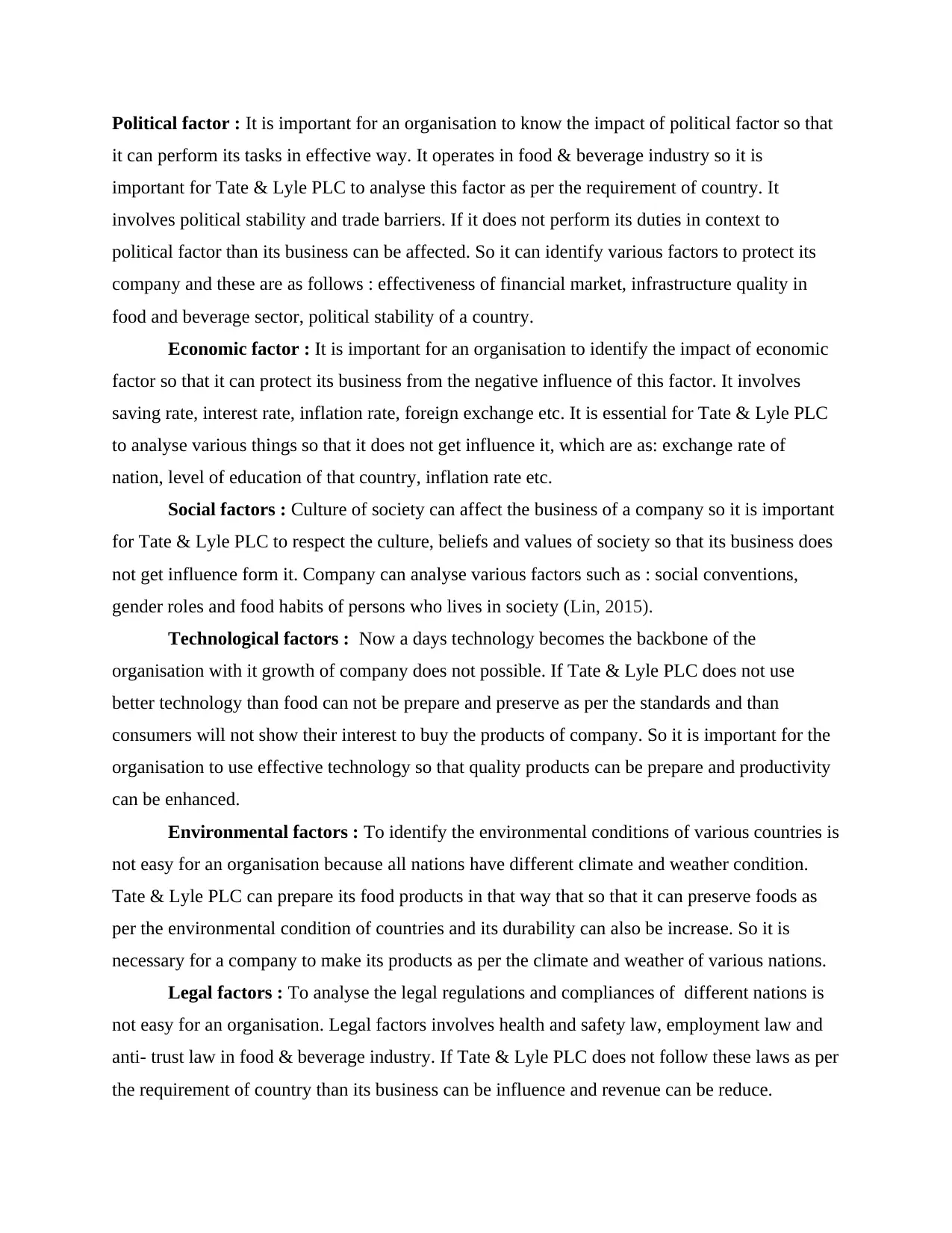
Political factor : It is important for an organisation to know the impact of political factor so that
it can perform its tasks in effective way. It operates in food & beverage industry so it is
important for Tate & Lyle PLC to analyse this factor as per the requirement of country. It
involves political stability and trade barriers. If it does not perform its duties in context to
political factor than its business can be affected. So it can identify various factors to protect its
company and these are as follows : effectiveness of financial market, infrastructure quality in
food and beverage sector, political stability of a country.
Economic factor : It is important for an organisation to identify the impact of economic
factor so that it can protect its business from the negative influence of this factor. It involves
saving rate, interest rate, inflation rate, foreign exchange etc. It is essential for Tate & Lyle PLC
to analyse various things so that it does not get influence it, which are as: exchange rate of
nation, level of education of that country, inflation rate etc.
Social factors : Culture of society can affect the business of a company so it is important
for Tate & Lyle PLC to respect the culture, beliefs and values of society so that its business does
not get influence form it. Company can analyse various factors such as : social conventions,
gender roles and food habits of persons who lives in society (Lin, 2015).
Technological factors : Now a days technology becomes the backbone of the
organisation with it growth of company does not possible. If Tate & Lyle PLC does not use
better technology than food can not be prepare and preserve as per the standards and than
consumers will not show their interest to buy the products of company. So it is important for the
organisation to use effective technology so that quality products can be prepare and productivity
can be enhanced.
Environmental factors : To identify the environmental conditions of various countries is
not easy for an organisation because all nations have different climate and weather condition.
Tate & Lyle PLC can prepare its food products in that way that so that it can preserve foods as
per the environmental condition of countries and its durability can also be increase. So it is
necessary for a company to make its products as per the climate and weather of various nations.
Legal factors : To analyse the legal regulations and compliances of different nations is
not easy for an organisation. Legal factors involves health and safety law, employment law and
anti- trust law in food & beverage industry. If Tate & Lyle PLC does not follow these laws as per
the requirement of country than its business can be influence and revenue can be reduce.
it can perform its tasks in effective way. It operates in food & beverage industry so it is
important for Tate & Lyle PLC to analyse this factor as per the requirement of country. It
involves political stability and trade barriers. If it does not perform its duties in context to
political factor than its business can be affected. So it can identify various factors to protect its
company and these are as follows : effectiveness of financial market, infrastructure quality in
food and beverage sector, political stability of a country.
Economic factor : It is important for an organisation to identify the impact of economic
factor so that it can protect its business from the negative influence of this factor. It involves
saving rate, interest rate, inflation rate, foreign exchange etc. It is essential for Tate & Lyle PLC
to analyse various things so that it does not get influence it, which are as: exchange rate of
nation, level of education of that country, inflation rate etc.
Social factors : Culture of society can affect the business of a company so it is important
for Tate & Lyle PLC to respect the culture, beliefs and values of society so that its business does
not get influence form it. Company can analyse various factors such as : social conventions,
gender roles and food habits of persons who lives in society (Lin, 2015).
Technological factors : Now a days technology becomes the backbone of the
organisation with it growth of company does not possible. If Tate & Lyle PLC does not use
better technology than food can not be prepare and preserve as per the standards and than
consumers will not show their interest to buy the products of company. So it is important for the
organisation to use effective technology so that quality products can be prepare and productivity
can be enhanced.
Environmental factors : To identify the environmental conditions of various countries is
not easy for an organisation because all nations have different climate and weather condition.
Tate & Lyle PLC can prepare its food products in that way that so that it can preserve foods as
per the environmental condition of countries and its durability can also be increase. So it is
necessary for a company to make its products as per the climate and weather of various nations.
Legal factors : To analyse the legal regulations and compliances of different nations is
not easy for an organisation. Legal factors involves health and safety law, employment law and
anti- trust law in food & beverage industry. If Tate & Lyle PLC does not follow these laws as per
the requirement of country than its business can be influence and revenue can be reduce.
Paraphrase This Document
Need a fresh take? Get an instant paraphrase of this document with our AI Paraphraser

CONCLUSION
As from the above report, it has been concluded that through the ratio analysis
organisation can know its liquidity, solvency and profitability. Through internal and external
factor analysis both organisation can protect its business from the negative impact of this. So it is
important for the corporation to analyse the financial statements effectively so that it can know
its financial position.
As from the above report, it has been concluded that through the ratio analysis
organisation can know its liquidity, solvency and profitability. Through internal and external
factor analysis both organisation can protect its business from the negative impact of this. So it is
important for the corporation to analyse the financial statements effectively so that it can know
its financial position.
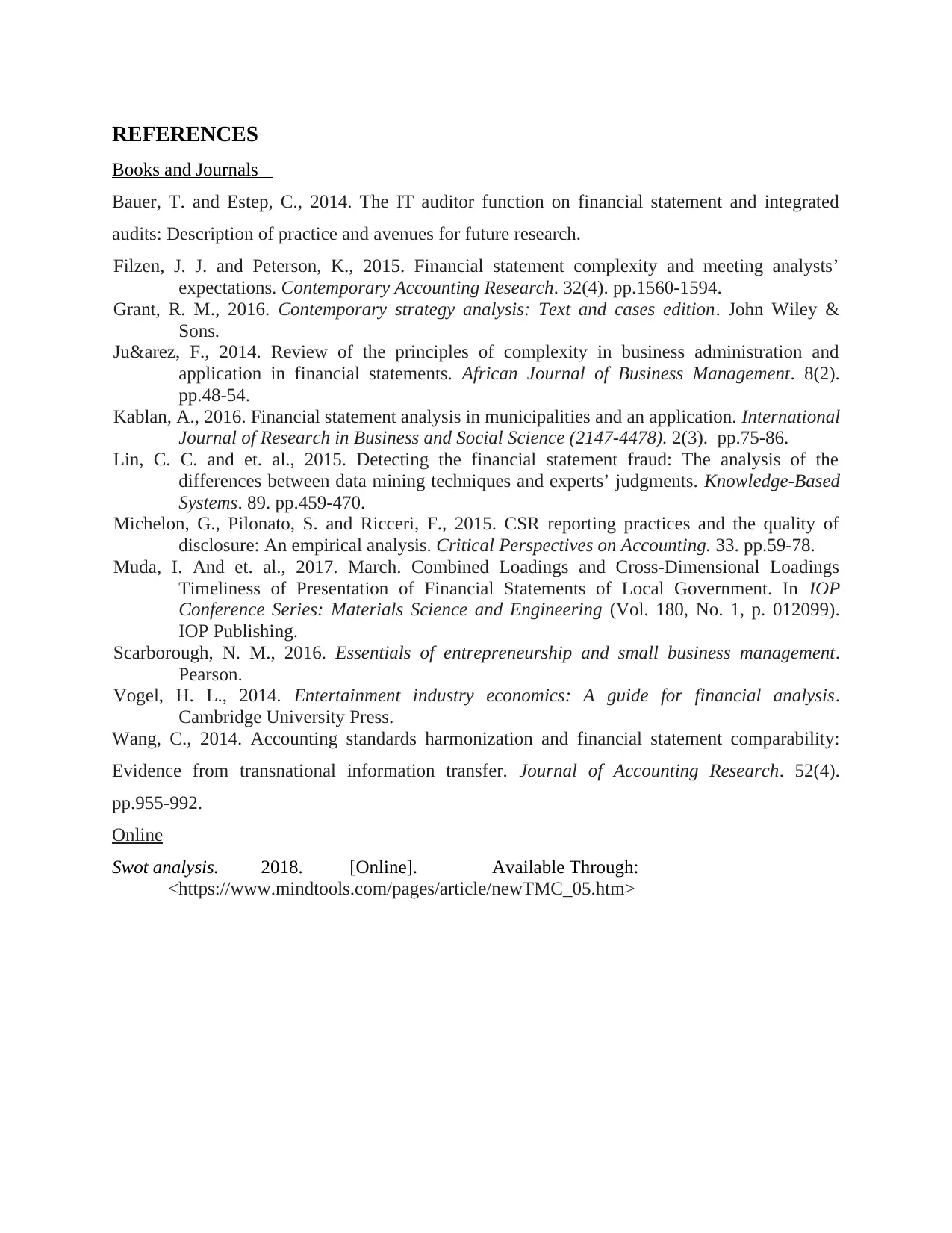
REFERENCES
Books and Journals
Bauer, T. and Estep, C., 2014. The IT auditor function on financial statement and integrated
audits: Description of practice and avenues for future research.
Filzen, J. J. and Peterson, K., 2015. Financial statement complexity and meeting analysts’
expectations. Contemporary Accounting Research. 32(4). pp.1560-1594.
Grant, R. M., 2016. Contemporary strategy analysis: Text and cases edition. John Wiley &
Sons.
Ju&arez, F., 2014. Review of the principles of complexity in business administration and
application in financial statements. African Journal of Business Management. 8(2).
pp.48-54.
Kablan, A., 2016. Financial statement analysis in municipalities and an application. International
Journal of Research in Business and Social Science (2147-4478). 2(3). pp.75-86.
Lin, C. C. and et. al., 2015. Detecting the financial statement fraud: The analysis of the
differences between data mining techniques and experts’ judgments. Knowledge-Based
Systems. 89. pp.459-470.
Michelon, G., Pilonato, S. and Ricceri, F., 2015. CSR reporting practices and the quality of
disclosure: An empirical analysis. Critical Perspectives on Accounting. 33. pp.59-78.
Muda, I. And et. al., 2017. March. Combined Loadings and Cross-Dimensional Loadings
Timeliness of Presentation of Financial Statements of Local Government. In IOP
Conference Series: Materials Science and Engineering (Vol. 180, No. 1, p. 012099).
IOP Publishing.
Scarborough, N. M., 2016. Essentials of entrepreneurship and small business management.
Pearson.
Vogel, H. L., 2014. Entertainment industry economics: A guide for financial analysis.
Cambridge University Press.
Wang, C., 2014. Accounting standards harmonization and financial statement comparability:
Evidence from transnational information transfer. Journal of Accounting Research. 52(4).
pp.955-992.
Online
Swot analysis. 2018. [Online]. Available Through:
<https://www.mindtools.com/pages/article/newTMC_05.htm>
Books and Journals
Bauer, T. and Estep, C., 2014. The IT auditor function on financial statement and integrated
audits: Description of practice and avenues for future research.
Filzen, J. J. and Peterson, K., 2015. Financial statement complexity and meeting analysts’
expectations. Contemporary Accounting Research. 32(4). pp.1560-1594.
Grant, R. M., 2016. Contemporary strategy analysis: Text and cases edition. John Wiley &
Sons.
Ju&arez, F., 2014. Review of the principles of complexity in business administration and
application in financial statements. African Journal of Business Management. 8(2).
pp.48-54.
Kablan, A., 2016. Financial statement analysis in municipalities and an application. International
Journal of Research in Business and Social Science (2147-4478). 2(3). pp.75-86.
Lin, C. C. and et. al., 2015. Detecting the financial statement fraud: The analysis of the
differences between data mining techniques and experts’ judgments. Knowledge-Based
Systems. 89. pp.459-470.
Michelon, G., Pilonato, S. and Ricceri, F., 2015. CSR reporting practices and the quality of
disclosure: An empirical analysis. Critical Perspectives on Accounting. 33. pp.59-78.
Muda, I. And et. al., 2017. March. Combined Loadings and Cross-Dimensional Loadings
Timeliness of Presentation of Financial Statements of Local Government. In IOP
Conference Series: Materials Science and Engineering (Vol. 180, No. 1, p. 012099).
IOP Publishing.
Scarborough, N. M., 2016. Essentials of entrepreneurship and small business management.
Pearson.
Vogel, H. L., 2014. Entertainment industry economics: A guide for financial analysis.
Cambridge University Press.
Wang, C., 2014. Accounting standards harmonization and financial statement comparability:
Evidence from transnational information transfer. Journal of Accounting Research. 52(4).
pp.955-992.
Online
Swot analysis. 2018. [Online]. Available Through:
<https://www.mindtools.com/pages/article/newTMC_05.htm>
⊘ This is a preview!⊘
Do you want full access?
Subscribe today to unlock all pages.

Trusted by 1+ million students worldwide
1 out of 12
Related Documents
Your All-in-One AI-Powered Toolkit for Academic Success.
+13062052269
info@desklib.com
Available 24*7 on WhatsApp / Email
![[object Object]](/_next/static/media/star-bottom.7253800d.svg)
Unlock your academic potential
Copyright © 2020–2025 A2Z Services. All Rights Reserved. Developed and managed by ZUCOL.





